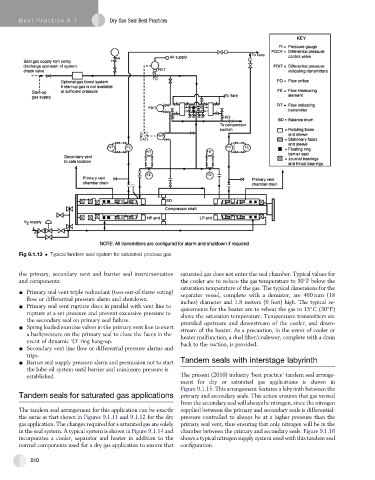Page 539 - Subyek Teknik Mesin - Forsthoffers Best Practice Handbook for Rotating Machinery by William E Forsthoffer
P. 539
Be st Practice 9 .1 Dry Gas Seal Best Practices
Fig 9.1.13 Typical tandem seal system for saturated process gas
the primary, secondary vent and barrier seal instrumentation saturated gas does not enter the seal chamber. Typical values for
and components: the cooler are to reduce the gas temperature to 30 Fbelow the
saturation temperature of the gas. The typical dimensions for the
- Primary seal vent triple redundant (two-out-of-three voting) separator vessel, complete with a demister, are 460 mm (18
flow or differential pressure alarm and shutdown.
inches) diameter and 1.8 meters (6 feet) high. The typical re-
- Primary seal vent rupture discs in parallel with vent line to quirements for the heater are to reheat the gas to 15 C(30 F)
rupture at a set pressure and prevent excessive pressure to above the saturation temperature. Temperature transmitters are
the secondary seal on primary seal failure. provided upstream and downstream of the cooler, and down-
- Spring loaded exercise valves in the primary vent line to exert stream of the heater. As a precaution, in the event of cooler or
a backpressure on the primary seal to close the faces in the heater malfunction, a dual filter/coalescer, complete with a drain
event of dynamic ‘O’ ring hang-up. back to the suction, is provided.
- Secondary vent line flow or differential pressure alarms and
trips.
- Barrier seal supply pressure alarm and permission not to start Tandem seals with interstage labyrinth
the lube oil system until barrier seal minimum pressure is
established. The present (2010) industry ‘best practice’ tandem seal arrange-
ment for dry or saturated gas applications is shown in
Figure 9.1.15. This arrangement features a labyrinth between the
Tandem seals for saturated gas applications primary and secondary seals. This action ensures that gas vented
from the secondary seal will always be nitrogen, since the nitrogen
The tandem seal arrangement for this application can be exactly supplied between the primary and secondary seals is differential-
the same as that shown in Figures 9.1.11 and 9.1.12 for the dry pressure controlled to always be at a higher pressure than the
gas application. The changes required for a saturated gas are solely primary seal vent, thus ensuring that only nitrogen will be in the
in the seal system. A typical system is shown in Figure 9.1.14 and chamber between the primary and secondary seals. Figure 9.1.16
incorporates a cooler, separator and heater in addition to the shows a typical nitrogen supply system used with this tandem seal
normal components used for a dry gas application to ensure that configuration.
510

